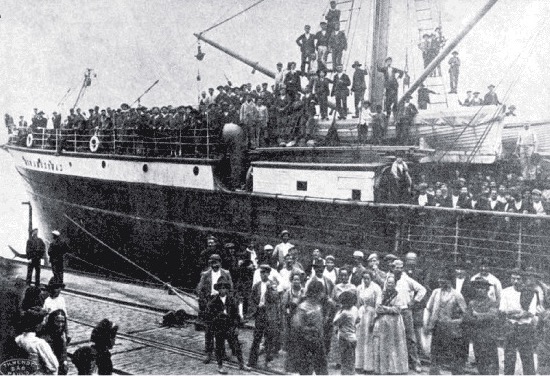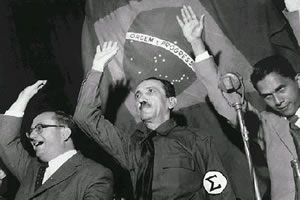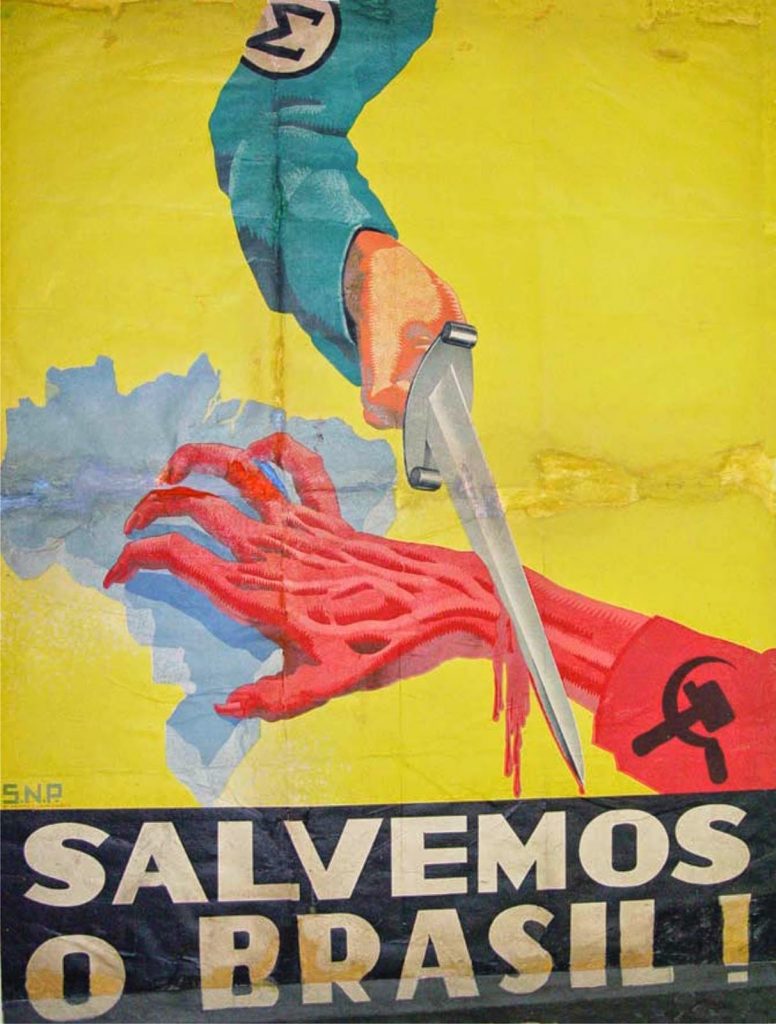Italian Influence on Brazilian Fascism
Calvin Bader

The Integralist Congress in Blumenau, Brazil, 1935.
While Italian Fascism never gained the reach or power that its founder, Benito Mussolini, desired, it had more influence than is often admitted. In the early 1900s, Italian immigration resulted in the creation of Italian communities all around the world, but Italians were especially attracted to South America. Italians settled in many South American countries such as Argentina, Uruguay and Brazil. By 1935, there were approximately three million Italians in Brazil, and about one-sixth of them retained their Italian citizenship (Seitenfus, 505). These Italians began to be integrated into Brazilian society and created roles for themselves in many Brazilian communities, especially in Sao Paolo. Italian immigrants and the Fascist government were very involved in the spread of fascism in Brazil and this demonstrates the impact that Italians had on Brazilian ideology and culture in the twentieth century, even if Fascism never gained the power and authority in Brazil that Mussolini desired.

Italian immigrants in the Port of Santos, 1907.
THe Introduction of Fascism in Brazil
Although the nationalist mindset of Mussolini would have preferred no Italian reside outside of Italy, except in the Italian colonies. Unable to completely prevent migration, Mussolini saw Italians as a way to spread and strengthen Fascist foreign policy (Goebel, 237). The Fascist government wanted to “exert maximum Italian influence in the region” in order to best serve their purposes. As a result, Fascist groups, called fasci, began to emerge in Brazil, encouraged by the Italian Fascist government and often led by Italian immigrants. By 1927, there were 52 fascist groups and by 1934, there were 82, with 35 of these groups being in Sao Paolo alone (Pinna, 6). In 1927, Amadeo Fani, a delegate of the secretary general of the fasci all’estero [fascist groups abroad], wrote that Italian immigrants and their descendants “felt strongly Italian and that there were many ardent supporters of Mussolini among them” (Goebel, 240). He explained that this was likely the case because Italians were less assimilated in Brazil than they were elsewhere in South America, such as in Argentina (Goebel, 240). Italian fascism began to take hold and have great influence around the country, often because of Italian immigrants.

Benito Mussolini in Genoa, May 1938.
Italian Fascist Programming and Propaganda in Brazil
The Fascist government of Mussolini attempted to “socialize” people into the movement through “communal schools, cultural associations, and social assistance” (Deutsch, 129). Italian immigrants found a need to build schools in order to maintain their cultural identity and language through the education of their children. These Italian schools were often subsidized by the Italian government, even before Fascism (Barausse and Luchese, 444). Mussolini’s Fascist government took advantage of these schools as a way to promote Fascist propaganda and maintain loyalty to the motherland. In the state of Rio Grande do Sul, this influence was particularly strong. Fascist celebrations would take place in honor of Italian holidays and important dates such as a celebration on the 50th anniversary of Giuseppe Garibaldi’s death. However, between 1937 and 1942, the Brasilian government began to place restrictions on these schools to diminish their influence (Barausse and Luchese, 448). The “Italian Schools” became “Italian-Brazilian Schools” and rather than maintain Italian identity and culture these schools shifted to teaching Italian immigrants Portuguese and Brazilian tradition and history to better integrate them into Brazilian society (Barausse and Luchese, 460).
Italian women played an important role in the maintenance of Italian identity and the spread of fascism in Brazil. Italian immigrant women became active in the local Italian cultures, spread nationalist and Fascist propaganda and participated in the Campaign of Gold to help in the conquest of Ethiopia (Deutsch, 129). Teachers in the Italian schools organized trips for children that helped to stimulate an allegiance to Fascism and mothers likely participated in the boycott of goods and films produced in countries that were imposing sanctions on Italy (Deutsch, 130). The campaign for the collection of gold and the sanctions imposed on Italy were the results of the second Italo-Ethiopian War. This war started in October 1935 when Italy invaded Ethiopia in order to create a new Italian empire (Sbacchi, 123).

The Department of Women and Youth of the AIB, the first official fascist party in Brazil.
The influence of Italian Fascism spread well beyond the classroom and into other aspects of Brazilian society. Mussolini’s government used newspapers as a way to spread Fascist propaganda quickly and easily to Italian immigrants in Brazil and native Brazilian citizens. The newspaper “Fanfulla,” a Brazilian paper in Italian founded in 1893, soon became a fascist newspaper (Pinna, 14). Even Brazilian newspapers that spoke out against Mussolini’s regime were taken over by fascist sympathizers. “Il Piccolo,” which criticized the Fascist movement of Mussolini in 1919 was eventually taken over by men who were sympathetic to his Fascist regime (Pinna, 15). Catholic-associated newspapers in Brazil were also promoting Mussolini’s movement. One newspaper, “Staffetta Riograndese” emphasized that “molti italo-brasiliani erano pronti ad arruolarsi per la patria lontana e segnalò con vigore le donazioni degli immigrati” [many Italian Brazilians were ready to enlist for the distant homeland and vigorously signaled the donations of immigrants] (Pinna, 17). The Fascist government also took advantage of organized sports among immigrants such as cycling and soccer as “strumenti di propaganda” [instrumenta of propaganda] (Pinna, 10). The Fascist state also supervised the professional Italian radio in Brazil and had an agreement of mutual cooperation with the Brazilian government to “favor and sway public opinion in Brazil in Italy’s favor” (Goebel, 242).

A fascist demonstration in Brazil, 1935.
THE creation of Brazil’s Fascist Party
The best display of the reach of Italian Fascism can be seen in the creation of Brazil’s own fascist party. Plinio Salgado was a writer and politician who became enamored with Mussolini and the doctrine of the Fascist party in Italy. On a trip to Italy in 1930, Salgado had his political views transformed by how the Fascist government held control, and this change was reinforced when he met Mussolini in person (Goncalves, 84). After his return to Brazil, Salgado set out to create a party that could mimic the Italian Fascist regime. So, in October of 1932, he officially established the Ação Integralista Brasileira [Brazilian Integralist Action] (AIB). The Integralist movement adopted many ideological stances that were similar to Fascism. The party was highly militarized and regimented, with many demonstrations and a strong anti-communist rhetoric.

Integralist Propaganda with their salute “Anauê,” which means “you are my brother” and believed to originate in a Tupi language expression.
Support for the AIB
While the success of the AIB was brief for many reasons, it thrived early on because of support from Italian immigrants, the Fascist government, and the Brazilian government of Getulio Vargas. Getilio Vargas, the president of Brazil from 1930-1937, and dictator of Brazil from 1937-1945, was heavily anti-communist, and thus supported the AIB in their early endeavors to fight communist sentiments in Brazil (Goebel. 242). The political and cultural environment in Brazil was favorable towards a right-wing movement, and there was large support of AIB from Italian Brazilian citizens (Bertonha, 148). It should be noted that the antifascist movement in Brazil was particularly weak, “ostacolato sia da un clima generale favorevole al regime italiano, sia dall’autoritarismo crescente del governo di Vargas a partire dalla fine degli anni Trenta” [obstructed both by a general climate favorable to the Italian regime, and by the growing authoritarianism of the Vargas government since the late 1930s] (Pinna, 23). Fascism, partly because of propaganda efforts by the Fascist regime, was “greatly popular among certain sectors of the government, the Brazilian Catholic Church and in general public opinion” (Bertonha, 153). The AIB was also supported from a wide spectrum of Italian Brazilians. Most of the support came from the upper and middle classes of Italian immigrants, although some support in the Rio de Plato region came from lower social classes (Bertonha, 148). The growing adherence “delle élites italo-brasiliane e dei ceti medi al fascismo fu sostenuta dalla visione nazionalista e dal crescente anticomunismo” [of the Italian Brazilian elites and the middle class was sustiained by the nationalist vision and increasing anticommunism] in Brazil (Pinna, 18).

Plinio Salgado, founder of the Brazilian fascist movement (center) at a rally, mid 1930s.
The AIB was called to the attention of the Fascist government by Enrico Menzinger, the Italian chargé d’affaire in Rio de Janeiro (Seitenfus, 509). Menzinger was clear in his reports that integralism was inspired by Fascism. Others in the Italian government with relations with the AIB considered the new political party to be the “figlio autentico e legittimo del fascismo” [the legitimate and authentic son of fascism] (Seitenfus, 512). The Italian government became even more directly involved with the AIB by supplying the party with a monthly sum of money for support (Seitenfus, 515). Salgado even sent Mussolini a message on the 15th anniversary of the march on Rome to congratulate il Duce on creating a global movement (Seitenfus, 517).
The Fall of the AIB
The initial success of the AIB was soon followed by its failure and collapse. The Fascist government disapproved of the integralist nationalism only because it threatened the freedoms of Italian immigrants with its harsh rhetoric (Seitenfus, 517). There was also a delicate balancing act that had to be performed by the Italian government. Although the AIB was quite influential at the height of its power, it never elected a president. The president, Getulio Vargas, also demonstrated strong leadership qualities and considered by many Italian diplomats to be a “heroic chief” (Seitenfus, 533). This balancing act would be unnecessary following November of 1937. The AIB was not happy with the amount of power they had gained, and they knew they would likely not win the upcoming presidential election. The integralists planned a military coup for November 10th, 1937, but it failed spectacularly and ultimately led to the collapse of the party (Seitenfus, 526). Vargas thwarted the attack on his palace and in the December of that year, established the Estado Novo, which made him a dictator, and then outlawed the AIB (Goebel, 244). Vargas drew inspiration from Mussolini’s government for his dictatorship, and his new constitution was “faithfully copied after European fascist charters” (Oren, 101). So, with the AIB destroyed, the Italian government shifted all their support to Vargas, which went very well until he joined the Allies in World War II in 1942 (Goebel, 245). This ended the brief life of the first official fascist political party in Brazil.

Brazilian propaganda announcing the declaration of war against the Axis powers on November 10th, 1943.
It is quite clear that immigrants and the beliefs they bring with them from their home countries can be quite influential. Italian immigrants in Brazil helped to establish connections between the Brazilian government and Mussolini’s Fascist regime. Immigrants, especially those in the middle and upper classes, were the foundations of support for Mussolini’s campaigns abroad as well as supporters of the fascist movement in Brazil, the AIB. The Italian government was deeply involved with the development of fascists movements in Brazil, with immigrants as their conduits. While the AIB fell, the legacy of Mussolini, Italian immigrants, and the influence of Fascism in Brazil is deserving of further research and attention.

AIB Propaganda against communist influence in Brazil.
Bibliography
Barausse, A, and T.A Luchese. “Nationalisms and Schooling: between Italianity and Brazility, Disputes in the Education of Italian-Gaucho People (rs, Brazil, 1930-1945).” History of Education and Children’s Literature. 12.2 (2017): 443-475.
Bertonha, João Fábio. “Fascism and Italian Communities in Brazil and the United States.” Italian Americana. 19.2 (2001): 146-157.
Deutsch, Sandra M. G. “Christians, Homemakers, and Transgressors: Extreme Right-Wing Women in Twentieth-Century Brazil.” Journal of Women’s History. 16.3 (2004): 124-137.
Goebel, Michael. “Italian Fascism and Diasporic Nationalisms in Argentina, Brazil, and Uruguay.” Immigration and National Identities in Latin America. Gainesville, University Press of Florida, 2014.
Goncalves, L.P. “The Integralism of Plínio Salgado: Luso-Brazilian Relations.” Portuguese Studies. 30.1 (2014): 67-93.
Oren, Ido. “Uncritical Portrayals of Fascist Italy and of Iberic-Latin Dictatorships in American Political Science.” Comparative Studies in Society and History. 42.1 (2000): 87-118.
Pinna, Pietro. “La Fascistizzazione Dei Migranti Italiani in Francia E Brasile: Una Comparazione.” Storicamente. 13 (2018).
Sbacchi, Alberto. “The Italians and the Italo-Ethiopian War, 1935-1936.” Transafrican Journal of History. 5.2 (1976): 123-138.
Seitenfus, Ricardo S. “Ideology and Diplomacy: Italian Fascism and Brazil (1935–38).” Hispanic American Historical Review. 64.3 (1984): 503-534.
Additional Readings
Bertonha, João Fábio. “Il Pensiero Corporativo in Miguel Reale: Interpretazioni Del Fascismo Italiano Nell’integralismo Brasiliano.” Diacronie. Studi Di Storia Contemporanea. 9.1 (2017): 1-15.
Bertonha, João Fábio. “Entre Mussolini E Plínio Salgado: O Fascismo Italiano, O Integralismo E O Problema Dos Descendentes De Italianos No Brasil.” Revista Brasileira De História. 21.40 (2001): 85-104.
Bertonha, João Fábio. “La “diplomacia Paralela” De Mussolini En Brasil: Vínculos Culturales, Emigratorios Y Políticos En Un Proyecto De Poder (1922-1943).” Pasado Y Memoria. (2012): 71-92.
Caprotti, Federico. “Overcoming Distance and Space Through Technology: Record Aviation Linking Fascist Italy with South America.” Space and Culture. 14.3 (2011): 330-348.
Nunes, Diego. “Extradition in Fascist Italy (1922-1943) and in Brazil of Getúlio Vargas (1930-1945) between the Ascension of “fascism Criminal Law” and the Survival of the Liberal Tradition of Criminal Law.” Sequência (florianópolis). (2018): 9-30.